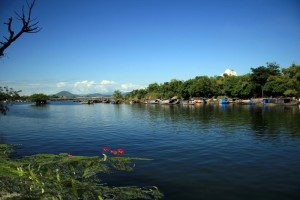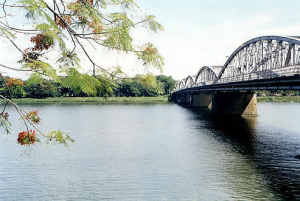Running across the heart of Hue City, featuring poetic beauty that wins over any visitors, Perfume River is an unmissable attraction in Hue. The river has many other names such as Lo Dung, Linh, Dinh, Kim Tra, Huong.
It was called Huong River because there is a lot of Thach Xuong Bo grass at the downstream sending its scent into the river. Thus, Huong River is not only beautiful but also fragrant. The foreigners also used the words rivière des Parfums (French) or Perfume of River (English) to translate name of the river. However, someone supposed that the word “Huong” was derived from proper name of Huong Tra district (previously Kim Tra), which the river flows through.
Huong River has 2 main sources originating from Truong Son mountain range. The Ta Trach (left tributary) comes from Dong Dai (Long Grotto), flows through 55 small and large waterfalls and t towards the Bang Lang fork. The Huu Trach (right tributary) derives from the East of Chan Son Mountain, runs through 14 waterfalls and meets the Ta Trach at the fork. From Bang Lang to the sea, the river is expanded and flows gently all the year. Apart from the floods, the river is year-round green.
Huong River is not very long, only 100 km long in total of which main river is only 30 km. From Bang Lang, Huong River slowly and gently flows across verdant villages of Hue countryside, enters the centre of the city and continues winding through the villages at its downstream before emptying into the sea. At main reach, Huong River has several important tributaries such as Bach Yen, Kim Long, Loi Nong, Thien Loc, Ke Van, Dong Ba rivers… some of them were made to protect Citadel or serve for agriculture. At the downstream, Huong River joins with Bo River at Sinh junction and O Lau River at Tam Giang Lagoon before emptying into the sea.
Huong River has a significant role to Hue’s urban architecture. From Kim Long capital (1630-1687) to precursor towns of today’s Hue such as Phu Xuan capital (1687-1712), Phu Xuan imperial capital (1738-1775), Phu Xuan ancient capital in Tay Son dynasty (1788-1801), all of them take Huong River as the main axis for urban planning and construction. Huong River is also considered as the natural trench protecting Hue imperial citadel, the important traffic route to every region throughout the country.
Huong River has a close relation with cultural life of Hue people. The traditional cultural activities such as folk song performance, boat racing, colored lantern release are still well-preserved. Huong River is also attached with poetry, music and painting . It is the inspiration of many popular poems, paintings, photos, and songs.
In Nguyen dynasty, the emperor Thieu Tri claimed Huong River as one of 20 landscapes of Than Kinh land and composed a poem named “Huong Giang Hieu Phiem”. The poem was carved onto a stone stele and put up on Huong River’s bank, next to Phu Van Lau. It has been well-preserved until now.




